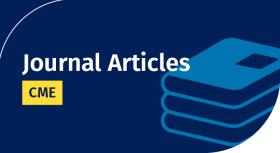
Summary for Clinicians: Clinical Practice Guideline for the Use of Nucleic Acid–Based Testing for Noninfluenza Viral Pathogens in Adults with Suspected Community-Acquired Pneumonia
Evidence-based guidelines were created in 2021 regarding the pertinence of nucleic acid–based testing of respiratory samples for noninfluenza viral pathogens in adults with suspected community-acquired pneumonia (CAP) by a multidisciplinary panel of experts. A systematic review of the literature was performed and applied the Grading of Recommendations, Assessment, Development and Evaluation approach to evaluate the quality of evidence and recommendations.
This summary of the clinical practice guideline is intended to provide the practicing clinician with key takeaway points and focuses on the utility of performing nucleic acid–based testing of respiratory samples for noninfluenza viral pathogens in various clinical settings, including routine settings and in those patients defined as having severe CAP or immunocompromising conditions.
The guideline implications of recommendation types may be applied variably for patients, clinicians, and policymakers. Clinicians should consider the unique clinical circumstances in each patient when applying clinical practice guidelines in patient management.
Target Audience
Pulmonologists, critical care specialists, translational researchers, and clinicians.
Learning Objectives
After reading this journal article, learners will be able to:
- Apply when to use nucleic acid-based testing for noninfluenza viral pathogens in adults with suspected community-acquired pneumonia (CAP).
- Identify which patient/clinical population should have nucleic acid-based testing of respiratory samples for noninfluenza viral pathogens.
- Apply their knowledge of nucleic acid-based testing and their potential impacts to treatments, identifying additional pathogens and infection control and prevention.
Accreditation Statement
The American Thoracic Society is accredited by the Accreditation Council for Continuing Medical Education to provide continuing medical education for physicians.
Disclosure Declaration
Article Authorship Disclosures (as submitted to the ATS prior to article publication date)
Ashley Losier, M.D. (Yale University School of Medicine, New Haven, CT, USA) reported no relevant financial relationships.
William C. Harding, M.D. (University of Texas McGovern Medical School, Houston, TX, USA) reported no relevant financial relationships.
Charles S. Dela Cruz, M.D., Ph.D. (Yale University, New Haven, CT, USA) reported no relevant financial relationships.
Scott Evans, M.D. (University of Texas M.D. Anderson Cancer Center, Houston, TX, USA) reported receiving royalties or licenses, having a patent, and having stock from Pulmotect, Inc.
Joseph K. Ruminjo, M.D. (American Thoracic Society, New York, NY, USA) reported no relevant financial relationships.
Carey C. Thomson, M.D., M.P.H. (Mt. Auburn Hospital, Cambridge, MA, USA) reported no relevant financial relationships.
Off-Label Usage Disclosure
None
Disclosures of AnnalsATS CME Planners
The Annals of the American Thoracic Society (AnnalsATS) original research, commentaries, reviews, and educational content of interest to clinicians and clinical investigators in pediatric and adult pulmonary and sleep medicine and medical critical care. The scope of the journal encompasses content that is applicable to clinical practice, the formative and continuing education of clinical specialists, and the advancement of public health.
The publication of articles that meet these goals by itself is only one step in a multi-step process for the translation of evidence-based improvements in are to clinical practice. Testing for CME credit is designed to function as a next step in the process. This is accomplished through a series of questions written by the author(s) to test that readers have the tools needed to translate recommendations for diagnostic and therapeutic clinical care into clinical practice. Members of the AnnalsATS editorial board review these questions and edit these questions for clarity, educational content, and the quality of the evidence supporting the response to the question.
AnnalsATS CME Planners
Alan M. Fein, M.D.
Podcast Editor, AnnalsATS
Dr. Fein reported that he has no financial relationships with commercial interests.
Constantine Manthous, M.D.
Associate Editor, AnnalsATS
Dr. Manthous reported that he has no financial relationships with commercial interests.
Gregory A. Schmidt, M.D.
Editorial Board, AnnalsATS
Dr. Schmidt reported payments for writing a textbook on critical care medicine (McGraw-Hill) and for writing contributions for UptoDate.
Instructions to Receive Credit
To receive credit for this journal article:
- Read the journal article. Keep track of how long it takes you to read it.
- Once you open the article, the Post-Test becomes available. After reading the article, answer the post-test questions. You must answer all questions correctly to earn credit. You may take the test as many times as you like.
- Once you pass the Post-Test, the Evaluation becomes available. Answer all the evaluation questions.
- Once you complete the evaluation, select the amount of credit to receive based on the time it took you to read the article.
- You can view, save and print your Certificate by pressing the Certificate button.
- To review the credits you've earned in this system and reprint certificates, go to the My Learning drop-down list. Then select Transcript.
Available Credit
- 1.00 AMA PRA Category 1 Credit(s)™The American Thoracic Society designates this for a maximum of 1.00 AMA PRA Category 1 Credit(s)™. Physicians should claim only the credit commensurate with the extent of their participation in the activity.
- 1.00 Participation

 Facebook
Facebook X
X LinkedIn
LinkedIn Forward
Forward